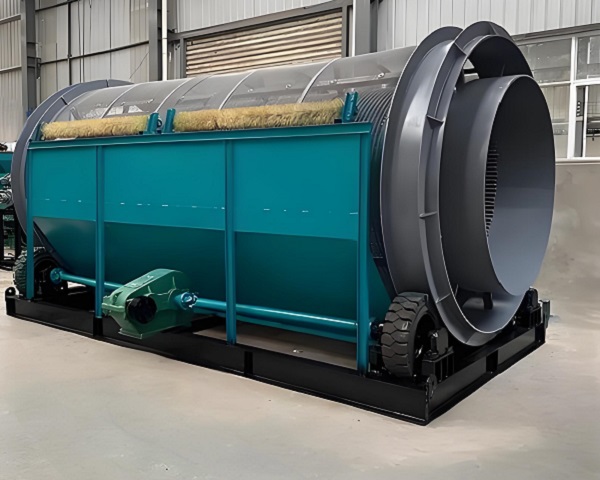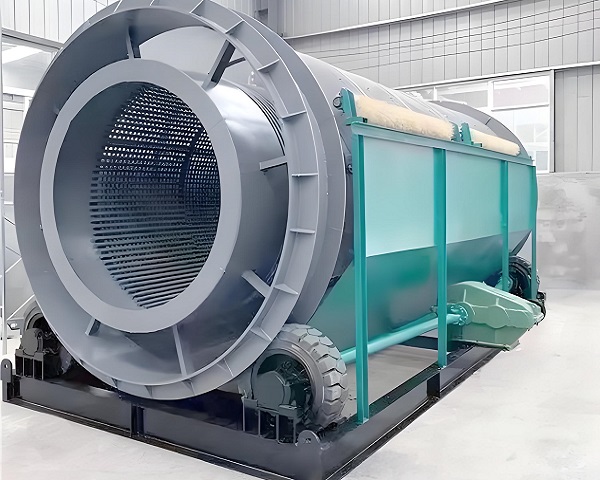In the process of the environmental protection industry moving towards high-quality development of "reduction, harmlessness, and resource utilization," screening equipment, as a key pretreatment link in pollution control, directly affects the efficiency and environmental benefits of subsequent processes. Rotary drum screens, with their unique advantages of rotary screening, have broken through the bottlenecks of traditional screening equipment in handling complex materials and have been widely used in core areas such as solid waste treatment, wastewater treatment, and soil remediation. They not only solve the pain points of complex material composition, large humidity fluctuations, and high grading accuracy requirements in environmental treatment, but also demonstrate significant value in improving resource utilization, reducing operating costs, and minimizing secondary pollution. This article will systematically review the core application scenarios and outstanding advantages of rotary drum screens, providing a reference for equipment selection and process optimization in the environmental protection industry.

Core Application Scenarios of Rotary
Drum Screens in the Environmental Protection Industry As a highly efficient screening device, the rotary drum screen, with its unique structural design and flexible operating modes, plays an irreplaceable role in core areas of the environmental protection industry such as solid waste treatment, wastewater treatment, and soil remediation, becoming a key pretreatment or deep separation device in pollution control processes.
In the field of solid waste treatment, the application of rotary drum screens is the most widespread and mature. Whether in municipal solid waste treatment plants, construction waste recycling projects, or industrial hazardous waste disposal centers, rotary drum screens play a crucial role in material grading and impurity separation. In municipal solid waste treatment, rotary drum screens use meshes of different apertures to separate recyclable materials such as kitchen waste, paper, and plastics from non-degradable impurities such as bricks, stones, and metals, providing homogenized raw materials for subsequent incineration power generation, composting, or landfill treatment, significantly improving processing efficiency and reducing equipment wear. In the field of construction waste recycling, rotary drum screens can precisely separate impurities such as soil and dust from recycled aggregates such as concrete blocks, gravel, and bricks, producing recycled aggregates of different particle sizes for use in the preparation of recycled concrete, permeable bricks, and other building materials, realizing the transformation of waste into treasure. Furthermore, in the treatment of industrial solid waste such as coal gangue and fly ash, rotary drum screens can effectively grade and screen, laying the foundation for the harmless disposal and resource utilization of solid waste.
In the wastewater treatment and sludge disposal industry, rotary drum screens are mainly used in the screening stage after wastewater pretreatment and sludge dewatering. In urban wastewater treatment plants, before wastewater enters the biological treatment system, rotary drum screens efficiently intercept large suspended solids and fibrous debris, preventing blockages in subsequent pumps, pipes, and reactors, and ensuring stable operation of the wastewater treatment system. In sludge disposal processes, dewatered sludge often contains impurities such as sand and metal particles. Rotary drum screens separate these impurities, making the sludge more homogeneous and facilitating subsequent landfill, incineration, or land application. Simultaneously, in industrial wastewater treatment, for wastewater containing particulate pollutants (such as mining wastewater and chemical wastewater), rotary drum screens can achieve preliminary solid-liquid separation, reducing the load on subsequent water treatment processes.

In soil remediation projects, rotary drum screens are a key pretreatment device for contaminated soil remediation. Soils contaminated with heavy metals and organic matter often contain impurities such as stones, tree roots, and construction waste. These impurities can affect the reaction efficiency and remediation effect of remediation agents. Rotary drum screens, through grading and screening, remove large impurities from the soil, refining soil particles to a uniform size, creating favorable conditions for subsequent chemical leaching, bioremediation, and other processes. Especially in projects such as farmland soil improvement and industrial contaminated site remediation, the application of rotary drum screens can significantly improve the uniformity and compliance rate of soil remediation.
Furthermore, rotary drum screens are widely used in sub-sectors such as pretreatment for waste incineration power generation, raw material grading for biomass energy utilization, and raw material purification for environmentally friendly building materials production, becoming an indispensable key piece of equipment in the environmental protection industry chain.
Core Advantages of Rotary
Drum Screens in the Environmental Protection Industry Compared to traditional screening equipment such as vibrating screens and fixed screens, rotary drum screens exhibit many unique advantages in environmental protection applications, enabling them to adapt to the complex needs of environmental treatment scenarios and improve treatment efficiency and environmental benefits.

1. High Screening Efficiency and Strong Adaptability Rotary drum screens adopt a rotary screening principle. Material makes full contact with the screen mesh inside the drum through gravity. Simultaneously, the rotation of the drum causes the material to continuously tumble and roll, avoiding accumulation and clogging on the screen mesh. This design makes rotary drum screens highly adaptable to materials with different moisture content and viscosity. Even easily agglomerated materials such as municipal solid waste and sludge with high water content can be screened efficiently. In environmental treatment, complex material composition and large humidity fluctuations are common problems. The advantage of rotary drum screens effectively solves the pain points of traditional screening equipment, such as easy clogging and low screening efficiency. Especially in scenarios like waste treatment and sludge disposal, it can significantly improve the efficiency of the overall treatment process.
2. Precise Grading and High Resource Utilization Rate Many treatment scenarios in the environmental protection industry have high requirements for material grading accuracy, such as the grading of recycled aggregates from construction waste and particle refinement in soil remediation. Rotary drum screens can be configured with screens of different aperture sizes according to actual needs. By controlling the drum rotation speed and material feed rate, precise grading of materials can be achieved, producing finished products with various particle size specifications. This precise grading capability not only meets the requirements of subsequent processing processes but also improves the resource utilization rate of materials. For example, in construction waste treatment, recycled aggregates precisely graded by rotary drum screens can be used in the production of building materials of different strength grades according to different particle sizes, increasing the added value of recycled resources; in municipal solid waste treatment, precisely separated recyclables can improve recycling rates and reduce resource waste.
3. Stable Operation, Low Energy Consumption and Maintenance Costs: The rotary drum screen features a simple and rational structural design, with core components being the drum and drive unit. With fewer moving parts, it experiences uniform force distribution, resulting in low vibration and noise during operation and high stability. Compared to equipment such as vibrating screens, the rotary drum screen consumes less energy, especially when processing large-scale materials, effectively reducing energy consumption in environmental protection projects and aligning with industry trends towards energy conservation and environmental protection. Furthermore, due to its stable operation, minimal wear on components, and convenient screen replacement, it significantly reduces maintenance frequency and costs. In environmental protection projects, long-term stable operation and low-cost maintenance directly impact operational efficiency; this advantage of the rotary drum screen saves environmental protection companies substantial operating costs and enhances project profitability.
4. Excellent Environmental Performance and Minimal Secondary Pollution: A core requirement for environmental protection equipment is meeting environmental performance standards and avoiding secondary pollution during processing. The rotary drum screen exhibits low vibration and noise during operation, effectively reducing noise pollution to the surrounding environment. Additionally, the equipment can be equipped with a sealed enclosure to prevent dust diffusion during screening; when used with dust removal equipment, it can achieve zero dust emissions. Furthermore, the low energy consumption of rotary drum screens reduces carbon emissions from energy consumption, aligning with the concept of green and environmentally friendly development. In locations with extremely high environmental requirements, such as waste treatment plants and sewage treatment plants, the environmental performance of rotary drum screens enables them to meet stringent environmental standards and avoid secondary pollution.
5. High Processing Capacity, Suitable for Large-Scale Environmental Protection Projects
With the large-scale development of the environmental protection industry, large-scale waste treatment plants, sewage treatment plants, and solid waste disposal centers have increasingly higher requirements for the processing capacity of screening equipment. Rotary drum screens can flexibly adjust their processing capacity by increasing the drum diameter and length, with a maximum processing capacity of hundreds of tons per hour, adapting to the processing needs of large-scale environmental protection projects. Whether it's the daily processing of thousands of tons of waste in municipal solid waste incineration power generation projects or the batch processing in large industrial solid waste disposal centers, rotary drum screens can stably meet the processing capacity requirements, ensuring the efficient operation of large-scale environmental protection projects.

With its high-efficiency screening capacity, wide adaptability, precise grading effect, and excellent environmental performance, the rotary drum screen plays an irreplaceable role in core areas of the environmental protection industry, such as solid waste treatment, sewage treatment, and soil remediation, becoming a key piece of equipment driving the high-quality development of the environmental protection industry. Its advantages in improving processing efficiency, reducing operating costs, and increasing resource utilization are highly aligned with the core objectives of the environmental protection industry: "reduction, harmlessness, and resource recovery."
With increasingly stringent environmental policies and continuous upgrades in environmental technologies, the application scenarios of drum screens will further expand, while also developing towards intelligence, large-scale production, and low energy consumption. For example, by introducing intelligent control systems, automatic adjustment of drum speed and feed rate can be achieved, improving screening accuracy and efficiency; by optimizing structural design, equipment energy consumption and maintenance costs can be further reduced. In the future, drum screens will play a greater role in pollution control and resource recycling in the environmental protection industry, providing strong support for achieving green and sustainable development.
Drum screens are used in key areas of the environmental protection industry, including solid waste treatment, wastewater treatment, and soil remediation. Through efficient screening and precise grading, they provide stable support for processes such as waste resource recovery, wastewater purification, and soil improvement, becoming an indispensable core piece of equipment in the environmental protection industry chain. Its core advantages are strong adaptability, precise grading, stable operation, excellent environmental performance, and large processing capacity. It not only solves the problems of easy clogging and high energy consumption of traditional equipment, but also meets the development needs of the environmental protection industry for "cost reduction and efficiency improvement, and resource recycling". With the tightening of environmental policies and technological upgrades, drum screens are iterating towards intelligence and large-scale production. In the future, they will play a more crucial role in large-scale pollution control and resource recycling, contributing to green and sustainable development.
Save Time! Get A Detailed Quotation Quickly.
